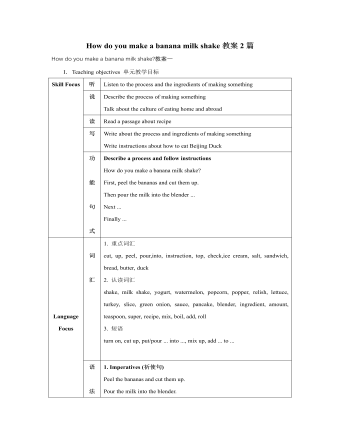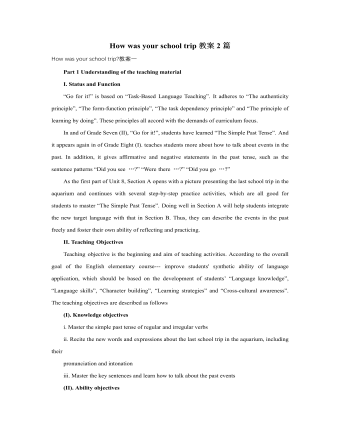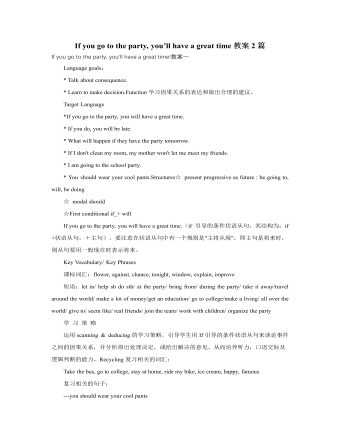热门搜索
人教版新目标初中英语八年级上册How do you get to school教案2篇文档

人教版新目标初中英语八年级上册How do you get to school教案2篇
Step Ⅶ Role play ( Work on 1b)1. First ask two students to read the dialogue to the class.Sa: How do you get to school?Sb: Well, I ride my bike to the subway station. Then I take the subway.2. Now work with a partner.Suppose you use two kinds of transportation to get to school \Hangzhou\Beijing... (bus, train, subway, walking, bike, etc.) Tell how you get there. You may use the phrases in 1a.3. Then ask different pairs of students to present their conversations to the class.Step ⅧListening1. Work on 2a(1) First ask students to read the list of information that Thomas wants to know.…where Nina lives.…how far from school she lives.…how long it takes to get to school.…how she gets to school.…what she thinks of the transportation.(2) Tell students what transportation and bus stop mean.bus stop 汽车站 transportation n. 运送;运输Then tell students we'll hear a recording. Please put a checkmark in front of each thing that Thomas wants to know.(3) Now play the recording for students.( Have students pay attention to the sample answer.) (4) Then correct the answers.
- 下载

人教版新目标初中英语八年级上册How do you get to school说课稿5篇
难点:1.学会谈论并描述使用某种交通工具到达某地。2.要求学生掌握好助动词do在不同人称特别是第三人称单数后的变化。通过合作学习将听说读写有机地结合起来,切实做到任务密集度适中,节奏合理,环节与环节之间过渡自然,让学生一步步登上高峰突破难点。五.说教学策略:1.教学手段分析:针对低起点的学生,在学习过程中通过“兵交兵,小组训练,鼓励性评价”等扶路措施,提高低起点学生的语言技能。针对高起点的学生要拔高学习目标,同时又能较好地运用到实践中去。2.教学方法分析:本课主要以“任务型教学法”并辅助与情境交际法完成任务的。在教学活动中采用任务型教学法让学生的学习活动具有明确的目标,并构成有梯度的连续活动。学生从注重语言本身转变为注重语言习得,从而获得语言运用的能力。我还采用情境交际法给学生足够的听,说的机会,联系实际,创设情景,在交际中学英语。
- 下载

人教版新目标初中英语七年级上册What time do you go to school教案
知识与能力复习词汇time,morning,breakfast,get up,g0 t0 bed,homework,clock,afternoon,lunch,run,watch TV,evening,dinner,eat,usually,o’clock,thirty,fifteen,take a shower,go t0 school等;引导学生复习、巩固“询问和谈论时间”的目标语言并运用所学知识安排自己的学习和课外活动。过程与方法运用Summarizing,Classifying和Comparing的学习策略。在复习教学中,运用听写、提问、对话演练与调查活动,促使学生不断地使用所学内容,从而提高他们灵活运用知识的能力。情感态度价值观本部分的主要内容是复习“日常作息时间”的询问和表达。通过互相询问或谈论自己或对方的作息时间安排和活动计划,培养学生良好的作息习惯和守时习惯。教学重、难点及教学突破重点复习词汇time,morning,breakfast,get up,g0 to bed,homework,clock,afternoon,lunch,run,watch TV,evening,dinner,eat,usually,o’clock,thirty,fifteen,take a shower,go to school等;引导学生复习、巩固“询问和谈论时间”的目标语言。
- 下载

人教版新目标初中英语八年级上册How do you make a banana milk shake教案2篇
1. First, ... then, ... next, ... finally, ...首先,……然后,……接着,……最后,……这是英语中表达做某事的步骤的一种说法。如果步骤较多,还可以说:first-next-after that-later on-finally/at last通常你会听到说英语国家的人在说 first, next, then, finally 和后面的内容时,他们会做一些停顿。这样就能提前告诉听者接下来讲的是一系列的步骤。这一点在朗读和听力中应特别注意。2. how many, how much均为疑问词,同是“多少”,但用法不同。请看:how many修饰可数名词复数,how much修饰不可数名词。但在用法上,同学们常犯如下错误:1) [误] How many are there bananas on the table?[正] How many bananas are there on the table?[析] how many, how much 中的many,much是形容词,常修饰名词作定语,故后面跟名词。2) [误]How much tea are there on the table?[正]How much tea is there on the table?[析] how much修饰不可数名词时,谓语动词用单数。how many与how much的区别可简记为:前how many:问“多少”,复数名词后面跑;how much问“多少”,不可数名词单数好。前者答语用基数词,后者答语用数量关系。
- 下载

人教版新目标初中英语八年级上册How often do you exercise教案2篇
单元目标与要求1.能够谈论自己、朋友或他人平时的活动,如:I often go to movies. He sometimes watches TV.等。2.能够谈论自己、朋友或他人平时活动的频率,如:I shop once a month. He watches TV twice a week..等。3.能听、说、读、写课后但此表中的黑体重点词汇和Grammar Focus 的重点句型。4.能够听、说、读A、B部分Pairwork中的对话;能够听懂简单的听力内容,并完成回答。5.能够理解Read中的大致内容,并能解决相应的问题。6.能够理解比并且完成Groupwork 和 Survey 。7.在Self-check 中完成综合运用,检验对本单元的掌握程度。8.通过本单元的学习,能引导学生关注自己以及身边的人对于日常生活的安排,养成合理安排生活起居及饮食好习惯。倡导健康生活,健康起居。课时安排4课时Period 1教学内容与分析?教学内容:(Section A 1a—2c) ?教学目标:a. 能够听、说、读、写平时的活动:exercise, go skateboarding。b. 能够听、说、认读句子:What do you usually do on weekends?I often go to the movies. What does she do on weekends? She sometimes watches TV.并能运用这些句型来描述自己和他人的平时活动。
- 下载

人教版新目标初中英语七年级上册Do you want to go to a movie教案
讨论喜欢的影视类型及理由:在看过一部影视作品后,大家总是喜欢在一起谈论影视的主要内容、主要情节、主要演员主题歌曲、主题音乐等,互相介绍自己对该影视的看法。教师可以组织一次活动,分组讨论学生喜欢看什么类型的电影,并说明喜欢的理由。运用I like…I don’t like…Because it is…等语言结构;然后每个组选派一名代表向全班学生阐述本组组员喜欢观看的电影类型;最后汇总,总结出全班同学最喜欢观看哪一种类型的电影。如果有可能,根据学生的选择放一部(一段)这种类型的影视节目。通过学生的讨论、调查,使他们在完成任务的过程中学会询问和陈述自己或别人在影视方面的喜好及理由,更好地巩固所学内容。Self Check教学内容Self Check(教材P58)教学目标知识与能力复习词汇go,movie,action,comedy,documentary,thriller,and,but,scary,funny, sad,exciting;引导学生复习、巩固“制订计划和打算并谈论喜好和偏爱”的目标语言。
- 下载

人教版新目标初中英语七年级上册Do you like bananas教案
教学目标 ⑴知识目标:A、学会询问对方喜欢与不喜欢的食物; B、学习并激情 些食物的词汇; C、学会谈论自己与他人早、中、晚 餐喜爱吃的食物; D、学会营养配。 ⑵能力目标:A、能准备表达喜欢和不喜欢的食物; B、能根据具体情景对话,与他人沟通信息,合作完成任务; C、通过听、说、读、写四项技能的训练,促进学生语言运用能力的提高。⑶情感目标:A、通过学习西文食品文化,促使学生了解西方生活方式与文化,培养跨 文化交际的意识; B、通过开展小组活动,指导学生积极与他人合作,培养他们的合作精神; C、通过任务型活动,使学生学会在实际生活中均衡饮食,合理配餐。 教学重点、难点 重点:A动词like一般现在时的各种句式及一般疑问句的肯定、否定回答; B关于各种食物的词汇; C名词复数的使用。 难点:一般现在时中单数第三人称的变化形式。
- 下载

人教版新目标初中英语七年级上册What time do you go to school说课稿
人教版《新目标英语》七年级上册第十一单元中心话题是通过对日常生活作息时间的谈论,让学生学会时间的表达法。主要学习用what time和when来引导的特殊疑问句询问时间的标准用法,还有不同时间段的表达法以及表示频率副词的学习。通过本单元的学习使学生学会不同时间段的表达法,学会用频率副词谈论自己日常生活习惯。通过对不同时间段的系统 学习和理解,学会调整和安排自己的学习和课外活动时间,能够运用所学知识对某一活动进行合理的安排;使学生深刻理解时间的重要性, 学会珍惜时间,并逐步养成良好的作息习惯。我现在说的这节课是本单元的第一课时。时间的重要性是众所周知的,生活中我们经常谈论某人在何时做了某事,可是 怎样才能用正确的时间表达方法来描述呢?在学生学过了一些数词和日常行为动作术语的基础上,教材在本单元的开篇通过谈论日常作息时间安排的对话来让学生认知时间,表达时间,适时而又合理。
- 下载

人教版新目标初中英语八年级上册How was your school trip教案2篇
“Go for it!” is based on “Task-Based Language Teaching”. It adheres to “The authenticity principle”, “The form-function principle”, “The task dependency principle” and “The principle of learning by doing”. These principles all accord with the demands of curriculum focus.In and of Grade Seven (II), “Go for it!”, students have learned “The Simple Past Tense”. And it appears again in of Grade Eight (I). teaches students more about how to talk about events in the past. In addition, it gives affirmative and negative statements in the past tense, such as the sentence patterns “Did you see …?” “Were there …?” “Did you go …?” As the first part of Unit 8, Section A opens with a picture presenting the last school trip in the aquarium and continues with several step-by-step practice activities, which are all good for students to master “The Simple Past Tense”. Doing well in Section A will help students integrate the new target language with that in Section B. Thus, they can describe the events in the past freely and foster their own ability of reflecting and practicing. II. Teaching ObjectivesTeaching objective is the beginning and aim of teaching activities. According to the overall goal of the English elementary course--- improve students' synthetic ability of language application, which should be based on the development of students’ “Language knowledge”, “Language skills”, “Character building”, “Learning strategies” and “Cross-cultural awareness”. The teaching objectives are described as follows(I). Knowledge objectivesi. Master the simple past tense of regular and irregular verbsii. Recite the new words and expressions about the last school trip in the aquarium, including their pronunciation and intonation
- 下载

人教版新目标初中英语七年级上册Do you want to go to a movie说课稿2篇
[活动一]导入:利用多媒体课件展示一些电影海报,从漂亮的海报引入今天所要学习的新单词。师生活动:师问:What kind of movies are they?引出单词:comedy thriller action movie documentary[设计意图]通过多媒体给学生以直观感受,熟悉的海报画面使学生兴趣大增,激发求知欲,顺利进入新课。[活动二](1)演示《三枪》海报师问:What kind of movies is it? What’s his name?Yes,he’s Xiao Shenyang.Do you like him?....Do you know his English name?结论:I guess it’s a comedy.[设计意图]从大家喜爱的喜剧名星入手,让学生辨认电影类型,鲜亮的海报色彩,夸张的人物造型,使课堂气氛大增。[活动三]师生活动:Match these pictures with the mew words.[设计意图]运用所学英语单词,说出这些电影的类型。活动中充分运用, Do you want to go to this movies?这个一般疑问句,为下面小组活动打基础。[活动四]1b师生活动:Please listen and circle the kinds of movies you hear.[活动五]1c结对活动:看例子,让学生依照例子两人一组做下面的对话。Sample:A:Do you want to go to a movie?B:Yes,I do,I want to see a comedy.[设计意图]充分练习此对话,熟练掌握want to do 句型,句子中多让学生使用第三人称,正确掌握语法知识。
- 下载

人教版新目标初中英语八年级上册Can you come to my party教案3篇
Step 3 (3b)First, tell the students when we talk about our future plans, we often use: I’m+verb+ing When we talk about what we must do, we use have to. Ask the students to fill in the blanks in 3b. The answers are: shopping, go to see, a test, I’m going, my family. Step 4 (3c)Let the students write an e-mail message to a friend. Say why you can’t visit next. Before the exercise, ask the students to give some possible answers and write them on the blackboard. So the students will feel easy to finish the writing exercise. After they finish it, Let them to correct it in groups first. Each group chooses theirs best one to read in front of the whole class. Step 5 ( planning a party )First read the conversation in the box together. Then ask the students to turn to page 88.Write down everything you have to do next week. Write in all the things you have to do . Ask the students to look at the list. Ask them “What day are you free?” This is when you can have your party. Step 6 (Self check 1 )Let the students to fill in the blanks with the words given. Change the forms of the words if possible. Then make their own sentences. The answers are: visit, playing, have to, study, comeStep 7 (Self check 2)Imagine you are Marie. Read the information and look at your schedule. Write replies to the invitation.
- 下载

人教版新目标初中英语八年级上册How do you make a banana milk shake说课稿8篇
(五)教学过程1)在课的开始检查学生对单词短语的掌握2)1b,听力为了让学生了解香蕉奶的制作过程,让学生复述,是为了然他们用所学的重点 词汇进行练习、为后面制作水果沙拉奠定基础。3)2a2b的听力是为了复习how much 与how many的区别 ,因为七年级上册unit8涉及到的知识,所以2a2b训练的的真正目的是为了让学生更清楚的了解不可数名词的表达方式 :数词+量词 +of+不可数名词4)在学生完全弄懂事物的制作过程极其不可数名词的数量表达后,我安排他们进行制作水果沙拉的对话。这个对话是机动的,如果时间充足,我让他们按照自己的医院去选择材料进行对话的编排。这个话题既可以用到本科的重点句型,又可用到重点词汇。在这步抓住重点突出难点5)在consolidate 环节,我安排2个汉译英,4个有关how much/how many 的选择,让学生讲做题原因,让他们彻底弄懂不可数名词的数量表达。6)最后,为了加深学生对食物制作过程描述的巩固,让学生把所学知识从口落实到笔头
- 下载

人教版新目标初中英语八年级上册How often do you exercise说课稿5篇
1a ---1c教材分析:本单元以“How often do you exercise ?”为话题展开教学活动。首先学会恰当地使用频率副词及短语,再学会描述课余时间的活动安排和基本饮食结构。通过复习七年级学习过的动词短语,及本单元的听力练习,各种方式的口语交际活动和写作练习,使学生积极参与,合作,从而培养学生的综合语言运用能力。教材在本单元的开篇,即本课时,安排了关于谈论课余时间的各项活动,以及初步认识和使用频率副词,为进一步地使用频率副词及动词短语做语言知识上的准备。教学目标:A:语言目标:恰当使用always usually often sometimes hardly ever never 等频率副词和日常活动短语:watch TV go shopping read books exercise等。掌握句型: What do you usually do on weekends?I often go to the movies.What does she do on weekends ?She often goes to the movies.B:能力目标:学习描述课余时间的活动安排,初步培养学生的语言综合运用能力。C:德育目标:培养学生的逻辑表述能力,激发学生的积极思维,并使学生互相了解,增进友谊,加强人际交往,以形成良好的人际关系。
- 下载

人教版新目标初中英语九年级上册How do you study for a test教案2篇
内容提示本单元主要内容是学会利用verb十by/with gerund表示方式方法来讨论学习英语的策略,认识自己在学习方面的长处和不足。初步了解现在完成时的结构和用法。现在完成时由助动词have/has+动词的过去分词构成,主要表示过去发生的某一动作对现在仍有影响或造成的后果,常与already,yet,just,ever,never等副词连用。教学目标一、学习目标(Language Goal) 1. Talk about how to study . 学会讨论各种学习方法和策略。2. Find out your suitable learning methods. 找出适合自己的学习方法。 二、语言结构(Language Structures) 1. Verb + by with gerund by+动名词短语 表示“通过…途径,方法” 2. How questions have引导的特殊疑问句 三、目标语言(Target Language) 1. How do you study for tests ? 你是怎样准备考试的?Well , I study by working with my classmates. 哦,我和同学们一起学习。2. Have you ever studied with a group ? 你曾经参加过学习小组吗?Yes , I have . I’ve learned a lot that way . 是的,参加过。通过这种方式我学了许多。
- 下载

人教版新目标初中英语九年级上册What would you do教案
本课采用任务型教学法,用What would you do if you had a million dollars?这个问句,引出谈论假想情况的话题。 采用提问、启发和归纳的教法,让学生易于接受教材内容,培养学生的语言运用能力。 四、 教学过程设计 Step Ⅰ. Greet the whole class as usual. Step Ⅱ. Warming-up T: Do you have ten Yuan in your pocket? S1: No, I don’t. T: (Take out ten Yuan and give it to the student) OK, never mind. What would you do if it was yours? What would you do if you had ten Yuan? S1: I would buy snacks. T: OK, thank you. Sit down, please. (To the whole class) Just now, it was only ten Yuan. What about 100 Yuan? What would you doif you had 100 Yuan? S2: I’d buy a beautiful jacket. T: Thank you. (To the whole class) Now suppose you had a million dollars, what would you do? We know thatone dollar nearly equals eight Yuan, so that’s a large sum of money. Think it over carefully and tellme your ideas. What would you do if you had a million dollars? S3: I’d buy a big house. S4: I’d buy a sports car. S5: I’d put it in the bank. T: OK, stop here. Please look at the blackboard and guess what would I do if I had a million
- 下载

人教版新目标初中英语七年级上册Do you have a soccer ball教案
在这一单元中,学生要学会就有关人与物之间所属关系进行问答的句子。本单元大量引入有关运动的名词,要求学生彼此询问有无此类物品,并做出相应的回答。 同时学习表示建议的句型Let’s运动的形容词。 本单元所选用的话题来自学生所喜欢的生活片段,在教学中生生交流、师生交流会更融洽,会促进师生彼此间的了解,成功的教学还会让部分学生养成良好的运动习惯和收藏习惯。 教学目标 1) 语言知识:A.在询问对方是否有某物的对话中学会使用do和does引导的一般疑问句; B. 学会使用描述性的形容词来评价事物; C. 学会在对话中使用名词复数; D. 学会用祈使句来向对方提出建议. 2) 语言技能:A. 学会用祈使句询问某人是否有某物; B. 学会向他人提出建议的句子. 3) 学习策略:A.通过与同学讨论,做出猜测;
- 下载

人教版新目标初中英语八年级上册What are you doing for vacation教案2篇
Teaching goals : 1. Words & phrases: babysit ,get back , fishing , rent , think about , decide(on) , tourist etc. 2. How to talk about future plans . 3. 现在进行时表示将来计划或行动. 4. 特殊疑问句(where , when , how long引导) Important and difficult points : Drills :What are you doing for vacation ? I’m watching TV . When are you going ? I’m going … . How long are you staying ? We’re staying for five days . Teaching aids : cards and a tape ,a large wall calendar . Period 1 Teaching procedures : Step 1Leading in1. Free talk . 2. Put up the wall calendar . T: I’m staying home on Saturday (pointing to next Saturday ).Ss repeat . Ss: I’m staying home on Saturday . T: OK. Today we’ll learn how to talk about future plans. Step 2Pre-task SB Page 13 , 1a . 1. Look at the picture carefully and tell what you see in the picture . 2. Write the activities from the pictures in the box and add some more . 3. Practice reading . Step 3While-task1. Using the activities we write in 1a to make conversations .For example :What are you doing for vacation ? I’m visiting my uncle . 2. Pairwork .Practice in pairs . 3. 用第三人称练习对话.
- 下载

人教版新目标初中英语八年级下册If you go to the party, you’ll have a great time教案2篇
区分宾语从句、定于从句和状语从句宾语从句和状语从句,都叫做主从复合句。宾语从句主要是中考必考的,是初中阶段必掌握的从句,宾语从句主要是掌握三要素,所谓宾语从句,就是宾语在主从复合句当中充当宾语的一个句子,叫做宾语从句。主句的谓语动词是及物动词,后面如果是词或者是短语的话,是简单句,如果是句子的话,肯定是宾语从句。I know that he good at English.就是宾语从句,三要素,一要素是要注意连词,连词一共学了三类连词,一类连词是that口语当中可以省略,就像刚才说的那一句,I hear he is good at English.还有疑问代词、疑问副词,how where when,疑问代词、疑问副词。还有一类连词weather是否的意思,不是状语从句当中的如果,这一定要和如果区分开,这是是否。I don't know if he interested at English。宾语从句要注意if是连词。第二要素是语序,要用陈述举语序。比如说你家有几口人,我们都说How many people are there in you family?但是这是简单句,一旦说成宾语从句,你可以告诉我你家有几口人吗?Could you tell me how many people there are in you family ?
- 下载

人教版新目标初中英语八年级上册I’m going to be a basketball player教案3篇
教学目标1.知识目标:(1)学习What are you going to be when you grow up?/How are you going to do that?句式。(2)学会用英语描述有关职业的表达法。2.能力目标:(1)能够谈论为实现理想所做出的打算和安排。(2)能够谈论未来自己与他人理想的职业及原因。(3)能用英语描述课余时间的活动安排,最终具备表达综合信息的能力。3.情感目标:新学期到来之际,让他们在学习、体育、饮食、特长、读书等方面制定计划,教育学生合理安排自己的课外生活,思考自己的理想职业及适合自己的职业。教学重点、难点本单元的重点为“be going to”表将来,want to be, what,where, when,how引导的特殊疑问句。难点是语言目标的实现。教材分析本单元以I am going to be a basketball player为话题,共设计了三部分的内容:一、Section A该部分有4个模块。第一模块围绕Do you think these jobs are interesting?这一话题展开思维(1a)、听力(1b)、口语(1c)训练;
- 下载

人教版新目标初中英语八年级上册Can you come to my party说课稿5篇
二、教学设计与构思根据以上对教材的分析,同时针对学生学习外语存在一定困难的实际情况及学生的年龄特点,首先给学生营造一个温馨愉悦的氛围,创设一个接近学生生活的语言环境,激发学生的学习兴趣,让学生乐于参于以后的活动中,而且每一个环节都配有相应的动画或亲切的画面,让学生在看、听和感知中接受知识,陶冶情操。最后用清晰明了的方式总结知识要点,便于学生巩固复习。在评价学习上,采用多元化评价,尊重差异,富于感性。布置作业时,分两部分,由浅入深,照顾全体学生。三、教学文法通过五步教学法,精讲巧红,由浅入深,以学生为主体,开展师生双边活动。四、教学手段使用现代化教学手段,多媒体辅助教学贯穿整个教学过程,增加直观性和趣味性,提高教学效果。
- 下载